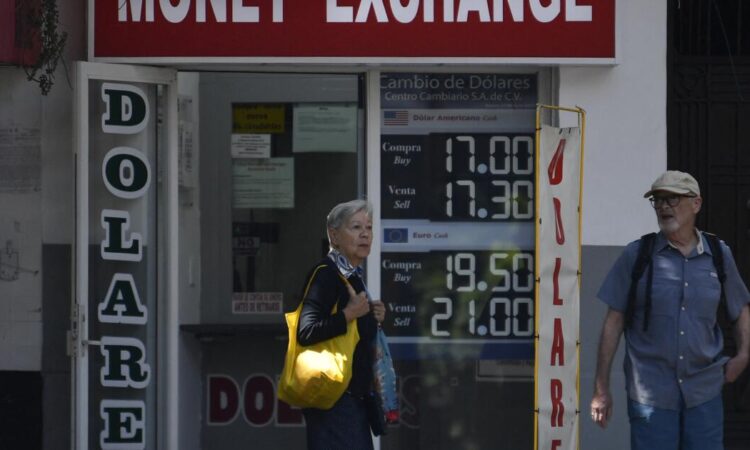
SAN BARTOLOMÉ QUIALANA, Mexico — Pedro Sánchez Martínez has spent decades as a contractor building houses for his neighbors in this farm town. Seven years ago, he set out to build one for his own family.
The pace of construction in rural Mexico, where mortgages are hard to come by, frequently depends on how quickly relatives working in the United States send dollars. Sánchez has relied on money transfers from two sons toiling as gardeners in California.
“I had hoped to be done in a year or so from now,” he said.
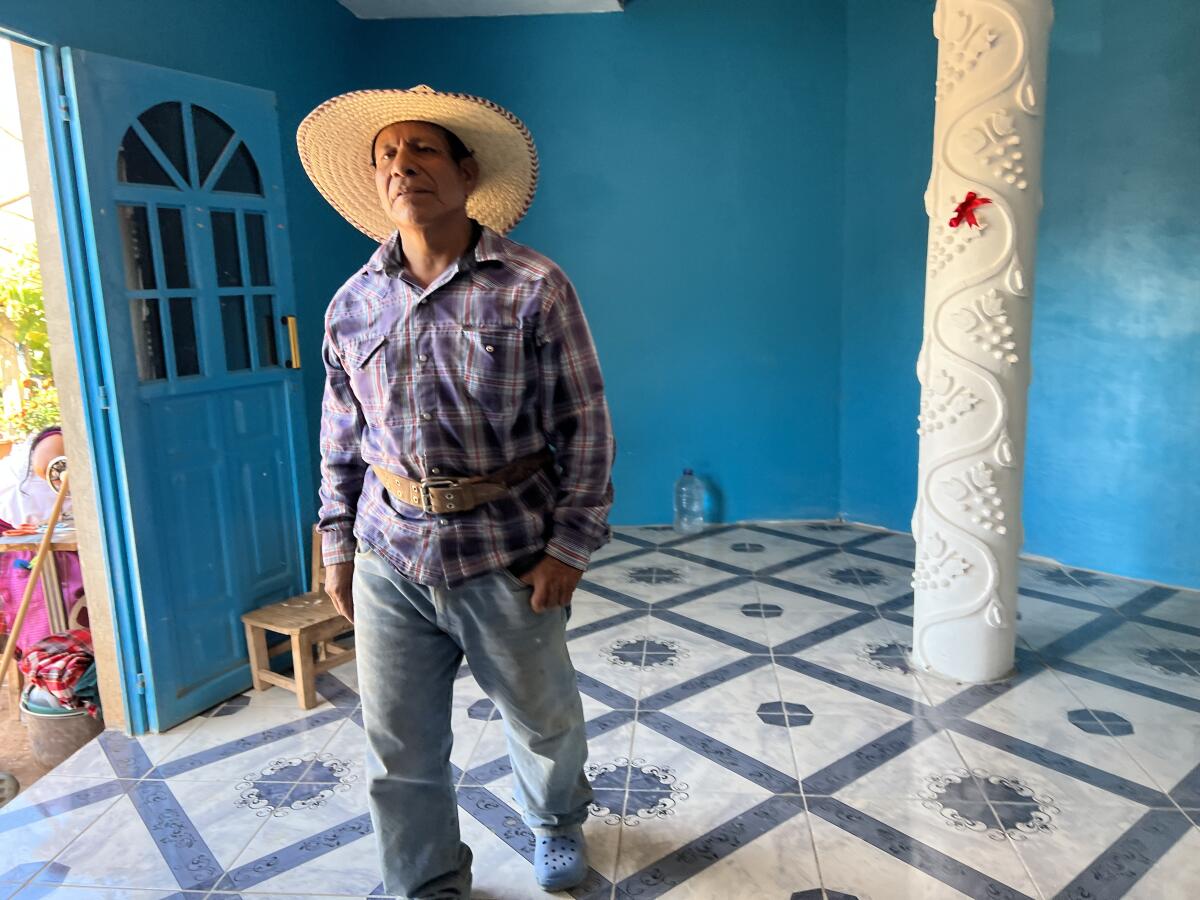
Contractor Pedro Sánchez Martínez started building his home in San Bartolomé Quialana, Mexico, seven years ago. He’d hoped to be done in a year, but the weaker dollar has added a couple of years to the timeline.
(Patrick J. McDonnell / Los Angeles Times)
But that was before the dawn of the “super-peso,” as the Mexican currency has been dubbed since steadily gaining 18% on the dollar during the last 12 months.
The peso’s emergence as one of the world’s mightiest currencies has prompted boasts from Mexican President Andrés Manuel López Obrador. But there has been no celebration among the millions of Mexicans who rely on remittances — including most of the 2,300 residents of San Bartolomé Quialana.
Here in the southern state of Oaxaca — among Mexico’s poorest — a weaker dollar means fewer pesos to buy livestock, food and other necessities, or pay for quinceañeras, marriages and funerals.
With more dollars now going toward basic expenses, home-building here has all but collapsed, leaving Sánchez, 57, with little work.
He expects it could take three more years to complete his house. He and his wife and their son, 20, moved in three months ago once it had a roof, a front door and a glossy living-room floor.
Concrete pillars with ornamental curlicues grace the interior. But it still lacks a kitchen, a bathroom, adequate plumbing and windows.
Sánchez estimates that he could finish the kitchen and the bathroom for 500,000 pesos — which was about $26,000 back in January but is now closer to $30,000.
“I don’t have that kind of money,” he said. “The dollar has lost its value.”
::
San Bartolomé is built on dollars.
There are few other sources of income in this sweeping valley, a rolling expanse of subsistence farms framed by the peaks of the Sierra Madre del Sur.
Remittances paid for most of the houses in town and helped finance public works, including a basketball court and renovations for a resplendent, 17th century church constructed with stones from a pre-Columbian temple. Each August, former residents now in Southern California hold fundraisers for their hometown’s annual fiesta.
San Bartolomé began dispatching migrants to the United States in the 1950s, the height of a joint government program that sent millions of Mexicans to California and elsewhere to work as farmhands known as braceros. The program shut down a decade later, but working in el norte was already becoming a rite of passage for young men.
“There’s a muchacho from here who just left — he made it to Los Angeles the next day,” said Clemente Sánchez, 57, the municipal president.
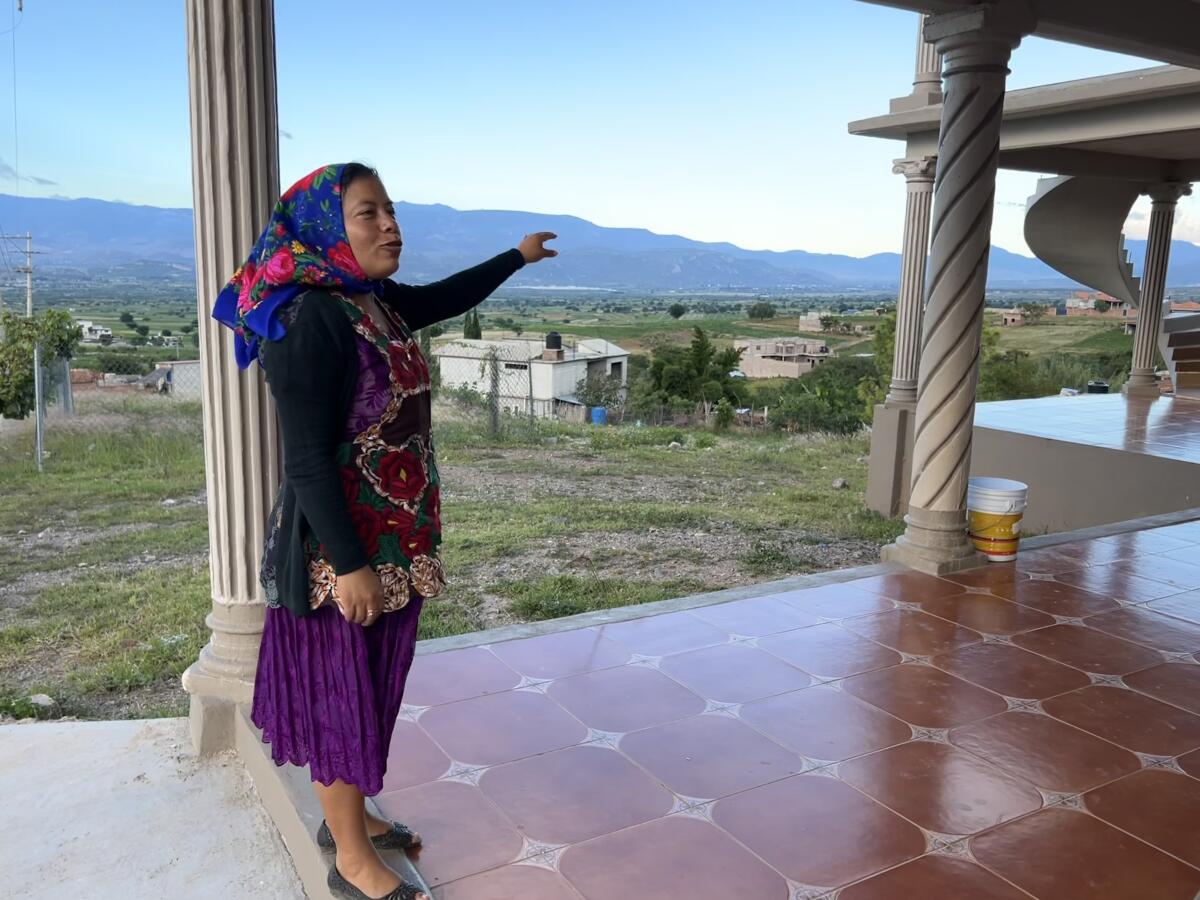
Marisela Morales lives at her uncle’s unfinished home in San Bartolomé Quialana. Her uncle, Maximino Morales, 70, sends money home from the U.S., where he has lived for 40 years, to build the house. He plans to retire there. “That’s my dream, to go back in a year or two and retire to my casita,” he said.
(Patrick J. McDonnell / Los Angeles Times)
As a teenager, he saw little future here, beyond subsistence farming and helping his father gather wood for charcoal along the slopes of the nearly 10,000-foot Cerro Picacho.
“I was only able to attend school until the fourth grade,” he said.
And so he too headed north, spending almost two decades in California. He only returned once he had sent back enough money to build several family houses. Now he works at the town hall, where one wall features a framed image of Benito Juárez, the iconic ex-Mexican president and a fellow Zapotec from Oaxaca.
Across the Mexican hinterlands, there are hundreds of towns and villages like San Bartolomé that rely on dollars as a lifeline.
Remittances to Mexico — almost all from the United States — have more than doubled during the last decade, totaling a record $58.5 billion in 2022, or 4.32% of the country’s gross national product, according to the World Bank.
That was a bigger share of the economy than oil or tourism. Only India, a country with more than 10 times the population, received more remittances than Mexico.
So many of the men of San Bartolomé are working in the United States that about 65% of the people who live here are women.
“Everything here is done by women,” said Aurora Sánches Gómez, 42, the town síndica, or legal representative. “We clean the ditches, mind the fields, take care of the children.”
On a recent morning, she was leading an animated, largely female brigade planting trees along the main road as they chatted among themselves in their Indigenous language, Zapotec. The women donned traditional woven blouses and skirts.
With her four brothers having left for the United States, Sánches and her sister care for their elderly parents.
“If my parents have to go to the doctor, my brothers send the money,” she said.
Each Sunday outside money-exchange establishments in Tlacolula de Matamoros, the market and banking hub a few miles from San Bartolomé, villagers from throughout the region line up to collect their remittances. They never see the dollars, which are converted into pesos.
Wary guards with shotguns eye the crowds as armored cars pull up and unload bundles of pesos in plastic bags to restock the bustling exchange houses.
Among those in line recently was Ciria Pérez, 37, from San Bartolomé.
Each month, Pérez explained, her husband, a gardener in Southern California, sends $300 or $400 for her and the couple’s three young daughters.
“The dollars used to be sufficient for us,” Pérez said as she waited outside the Elektra storefront.
“Now, with the value of the dollar going down, it’s hardly enough to feed my family, buy them clothes and supplies for school,” she said. “It seems like every week the dollar is worth less and less.”
::
Residents of San Bartolomé are acutely aware of exactly how many pesos one dollar buys.
In the spring of 2020, as the pandemic ravaged livelihoods worldwide, it was 25 — the most since Mexico allowed its currency to float in 1994.
By the end of that year, the dollar fell to about 20 pesos, where it hovered until last fall before starting to slide. This July, it dipped below 17 for the first time in more than seven years.
On Monday, a dollar bought 17.17 pesos.
One major factor behind the peso’s rise, experts say, is escalating foreign investment as multinationals serving the U.S. market are increasingly drawn to Mexico — a strategy known as near-shoring — amid rising U.S.-China tensions and worries about interruptions in industrial supply chains.
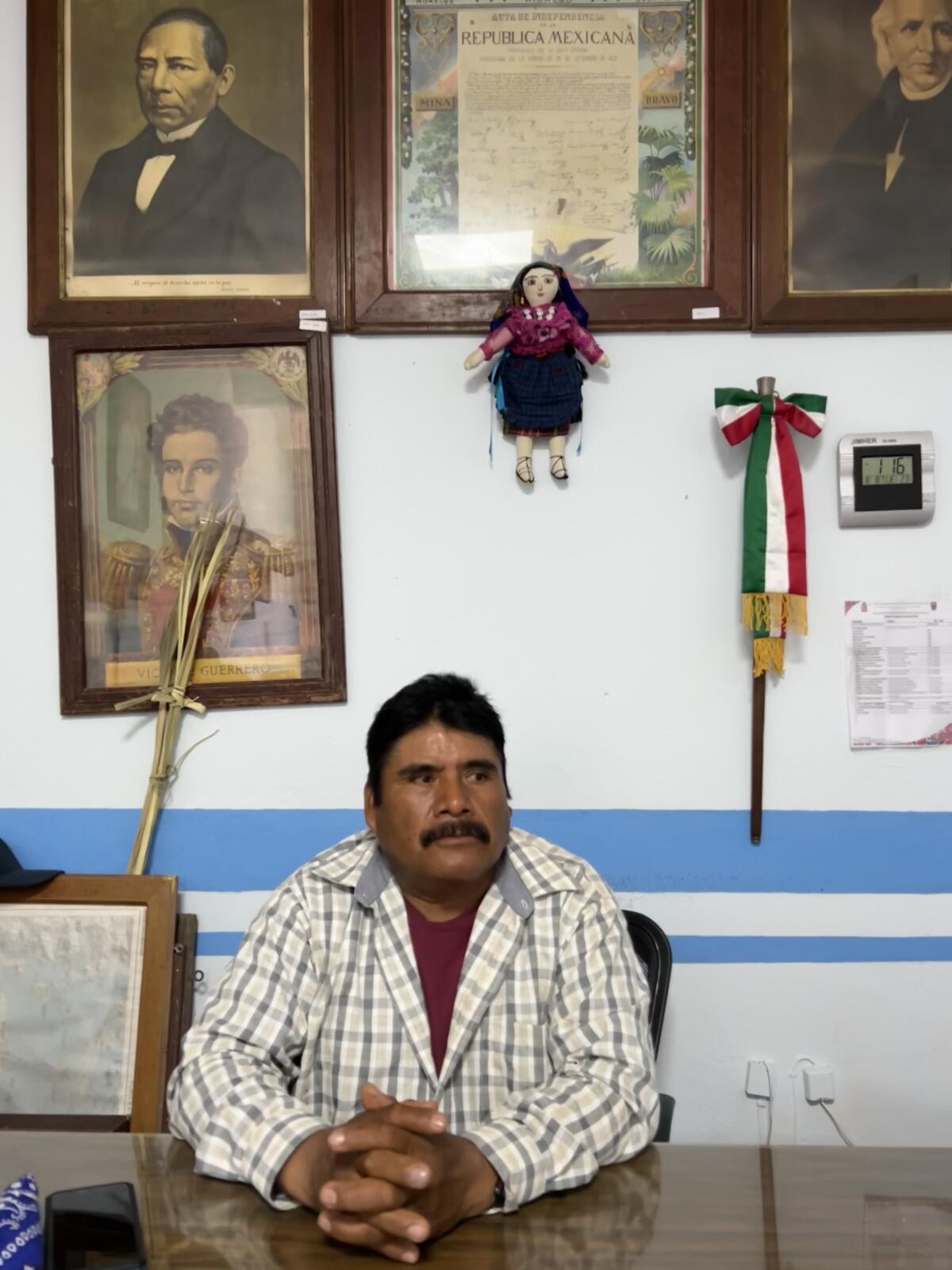
Clemente Sánchez, 57, municipal president of San Bartolomé Quialana, spent almost two decades in California. He only returned once he had sent back enough money to build several family houses. He says the increasing value of the peso has been a hardship for the town.
(Patrick J. McDonnell / Los Angeles Times)
Foreign investment in Mexico surged 48% in the first three months of 2023 compared with the same period last year, according to the economy ministry. Early this year Mexico became the top U.S. trading partner, surpassing Canada and China.
Another factor is Mexico’s aggressive fight against inflation. The Bank of Mexico’s benchmark interest rate of 11.25% is more than double the U.S. Federal Reserve target — a disparity that has drawn international investors hunting yields in pesos and peso-denominated bonds.
The surging tide of remittances from the United States has also played a role in driving up the peso.
“Wages have gone up a lot in the United States, especially in the low-end sectors like food service and hotels, real basic entry-level jobs, where a lot of immigrants work,” said Connel Fullenkamp, an economist at Duke University. “If your family back home tells you they aren’t doing well, you’ll do whatever you can to send more money.”
The peso’s power has become a talking point for the Mexican president, who credits his agenda of fiscal austerity and enhanced foreign trade.
“The peso has strengthened as never before,” López Obrador recently told reporters. “What does this mean? … That Mexico is a country with economic and financial stability.”
Economists tend to agree that the peso’s current potency is a sign of a healthy economy.
“Right now, Mexico is in kind of a sweet spot,” Fullenkamp said. “Most countries say they want a strong exchange rate, but they don’t want it too strong.”
The danger is that the peso overheats and deters foreign tourists from visiting or dampens Mexico’s booming export market, as goods as varied as oil, tequila and cars become more expensive.
And, of course, the more the peso rises the bigger the reduction in buying power of the dollars that Mexicans in the United States send back to their families.
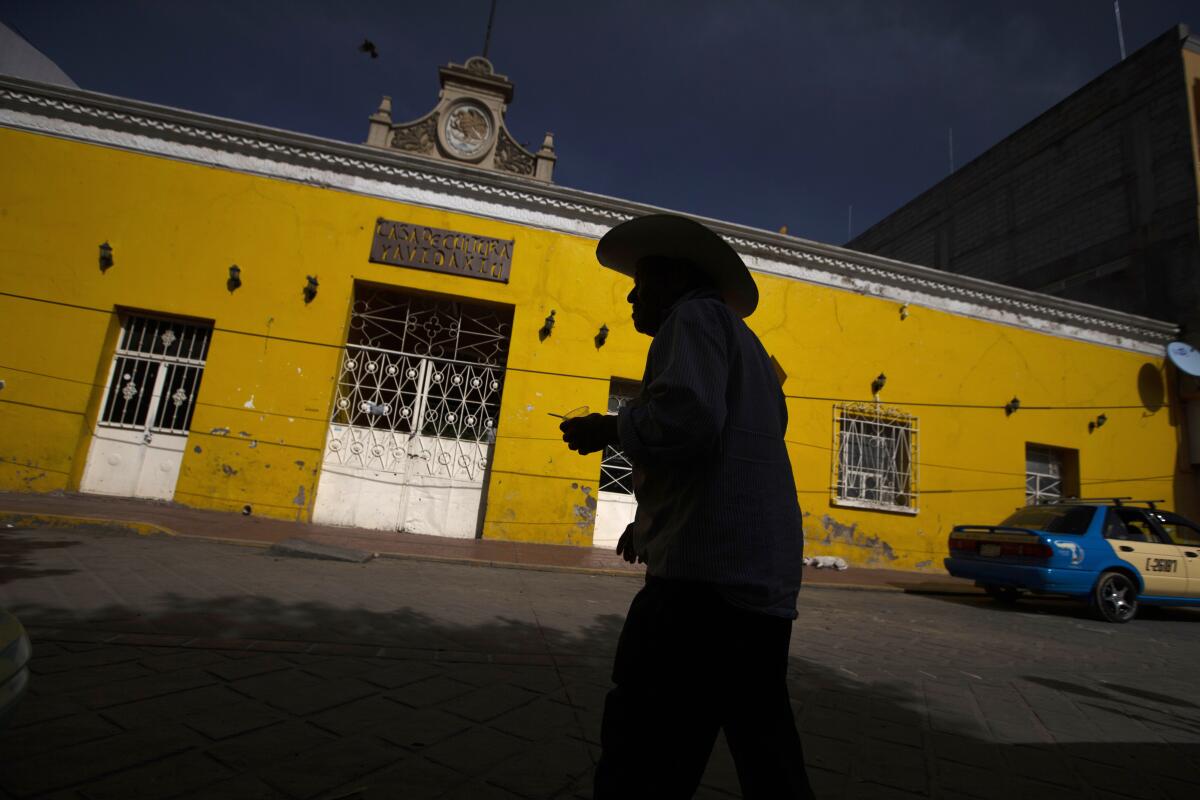
A customer leaves a bank where people receive international wire transfers in Acatlán de Osorio, Mexico, in 2020.
(Fernando Llano / Associated Press)
Remittances to Mexico are projected to increase 8.1% this year, according to Gabriela Siller Pagaza, chief economic analyst for Banco Base, a Mexican financial services firm. But, because of inflation and the super-peso, she recently tweeted, the purchasing power of those dollars is expected to fall 11% compared with last year.
The Mexican president lauds immigrants sending dollars back home as “anonymous heroes.” But some say it’s nothing to gloat about.
“It’s really a tragedy that so many of the country’s best young people feel they have to leave Mexico” to support themselves and their families, said Sofía Ramírez, an economist who heads the nonprofit research group México, ¿Cómo Vamos?
::
San Bartolomé has both simple residences and spacious, multistory homes. U.S. suburbia is the inspiration for many common touches: lustrous floors, decorative pillars, expansive lawns.
Most homes are for wives and children. Others are built for aging parents or as future retirement dwellings.
“That’s my dream, to go back in a year or two and retire to my casita,” Maximino Morales, 70, a native of San Bartolomé, said by phone from Washington state, where he works in agriculture. He has resided in the United States for more than 40 years.
His spacious home here — featuring balconies with panoramic vistas and a winding staircase leading to an upper floor — is almost complete. His niece and her daughter live in the house now and run a ground-floor grocery.
Morales anticipates that his dollars banked in the United States will someday buy pesos at a better rate, enabling him to finish the job.
“Right now, the dollar gives so little,” he lamented.
Pedro Sánchez, the contractor, who also holds the honorary post of mayor of San Bartolomé, likewise despairs of the weak dollar that has slowed construction. But he is proud of his work.
“Our homes here are a lot more solid than those in California,” he said. “We don’t use Sheetrock.”
His own house still has no furniture. Blankets are piled up in the bedrooms. Running water is erratic and the bathroom is outside.
“We have a lot to do,” said Sánchez.
Short on cash, Sánchez is contemplating a new plan: Returning to the United States, finding work and saving enough to complete his house.
“God willing, maybe that’s what I’ll do — go back to California,” he said. “I know how difficult life is there — the streets aren’t paved with gold, like many people in San Bartolomé think.
“One has to work very hard. And living there is expensive. Nothing is free. Here in San Bartolomé there is always enough to eat. But one can’t earn dollars like in California.”
Special correspondent Cecilia Sánchez Vidal in Mexico City contributed to this report.
